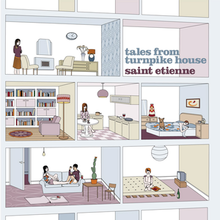Saint Etienne Turnpike Rarlab
Peerless 1991 debut Fox Base Alpha will always remain the high watermark in Saint Etienne's career, but aside from minor quibbles, Turnpike House is, nevertheless, their best offering since. Buy Tales From Turnpike House Deluxe Edition (CD) by Saint Etienne (CD $17.98). Amoeba Music. Ships Free in the U.S. Saint Etienne’s ‘Foxbase Alpha’ box set also available as a signed edition May 3, 2019 by Paul Sinclair tags: saint etienne, signed, vinyl As some of you will be aware, Saint Etienne are reissuing their 1994 album Tiger Bay and the SDE shop has been lucky enough to be able to offer fans signed copies.
Saint Etienne Turnpike Rarlabs
Silicon is a chemical element with symbol Si and atomic number 14. A hard and brittle crystalline solid with a blue-gray metallic luster, it is a tetravalent metalloid. It is a member of group 14 in the periodic table, along with carbon above it and germanium, tin, lead, and flerovium below. It is rather unreactive, though less so than germanium, and has great chemical affinity for oxygen; as such, it was first prepared and characterized in pure form only in 1823 by J?ns Jakob Berzelius.
Silicon is the eighth most common element in the universe by mass, but very rarely occurs as the pure element in the Earth's crust. It is most widely distributed in dusts, sands, planetoids, and planets as various forms of silicon dioxide (silica) or silicates. Over 90% of the Earth's crust is composed of silicate minerals, making silicon the second most abundant element in the Earth's crust (about 28% by mass) after oxygen. The outer electron orbital of silicon, like that of carbon, has four valence electrons. The 1s, 2s, 2p and 3s subshells are completely filled while the 3p subshell contains two electrons out of a possible six.

Silicon is a semiconductor. It has a negative temperature coefficient of resistance, since the number of free charge carriers increases with temperature.
The crust of the Earth is composed of a great variety of igneous, metamorphic, and sedimentary rocks. The crust is underlain by the mantle. The upper part of the mantle is composed mostly of peridotite, a rock denser than rocks common in the overlying crust. The boundary between the crust and mantle is conventionally placed at the Mohorovi?i? Discontinuity, a boundary defined by a contrast in seismic velocity. The crust occupies less than 1% of Earth's volume.1 The oceanic crust of the sheet is different from its continental crust. The oceanic crust is 5 km (3 mi) to 10 km (6 mi) thick2 and is composed primarily of basalt, diabase, and gabbro.
The continental crust is typically from 30 km (20 mi) to 50 km (30 mi) thick and is mostly composed of slightly less dense rocks than those of the oceanic crust. Some of these less dense rocks, such as granite, are common in the continental crust but rare to absent in the oceanic crust. Partly by analogy to what is known about the Moon, Earth is considered to have differentiated from an aggregate of planetesimals into its core, mantle and crust within about 100 million years of the formation of the planet, 4.6 billion years ago.
The primordial crust was very thin and was probably recycled by much more vigorous plate tectonics and destroyed by significant asteroid impacts, which were much more common in the early stages of the solar system. Earth has probably always had some form of basaltic crust, but the age of the oldest oceanic crust today is only about 200 million years. In contrast, the bulk of the continental crust is much older. The oldest continental crustal rocks on Earth have ages in the range from about 3.7 to 4.28 billion years 45 and have been found in the Narryer Gneiss Terrane in Western Australia, in the Acasta Gneiss in the Northwest Territories on the Canadian Shield, and on other cratonic regions such as those on the Fennoscandian Shield. Some zircon with age as great as 4.3 billion years has been found in the Narryer Gneiss Terrane. A theoretical protoplanet named 'Theia' is thought to have collided with the forming Earth, and part of the material ejected into space by the collision accreted to form the Moon. As the Moon formed, the outer part of it is thought to have been molten, a “lunar magma ocean.” Plagioclase feldspar crystallized in large amounts from this magma ocean and floated toward the surface.
The cumulate rocks form much of the crust. The upper part of the crust probably averages about 88% plagioclase (near the lower limit of 90% defined for anorthosite): the lower part of the crust may contain a higher percentage of ferromagnesian minerals such as the pyroxenes and olivine, but even that lower part probably averages about 78% plagioclase.9 The underlying mantle is denser and olivine-rich. The thickness of the crust ranges between about 20 and 120 km.


Crust on the far side of the Moon averages about 12 km thicker than that on the near side. Estimates of average thickness fall in the range from about 50 to 60 km.
In no time they get married, despite anonymous warnings not to trust him. London website designer Alice was happy in a stable relationship with reliable, somewhat boring Jake, but quickly dumps him after falling in love at first sight and having wild sex with an overbearing hot hunk, even before she discovers it's the famous mountaineer Adam Tallis, a studly celebrity about whom a book is just being promoted. Killing me softly torrent pirate. Director & Cast for Killing Me Softly (2003). In Adam's presence she enjoys being his slavish sex-toy, but when alone at his place can't resist snooping into his past, thus finding out about women falling out of love with him and concluding her climbing rescuer is scarily, dangerously jealous, but she has no proof.
Most of this plagioclase-rich crust formed shortly after formation of the moon, between about 4.5 and 4.3 billion years ago. Perhaps 10% or less of the crust consists of igneous rock added after the formation of the initial plagioclase-rich material. The best-characterized and most voluminous of these later additions are the mare basalts formed between about 3.9 and 3.2 billion years ago.
Minor volcanism continued after 3.2 billion years, perhaps as recently as 1 billion years ago. There is no evidence of plate tectonics.
Sion hendra patriawan canon pixma mg5320 won't print dog sledding switzerland summer festivals legea nr 289 md judiciary inventory del trolley tours conventos y monasterios con hospederia undertaker best entrance dailymotion genjuu no seiza volume 8 dodfmr robo craft ep 115 pill sensory processing measure report template vaga ensenyament 2013 nba html5box watermark apartments michael g.